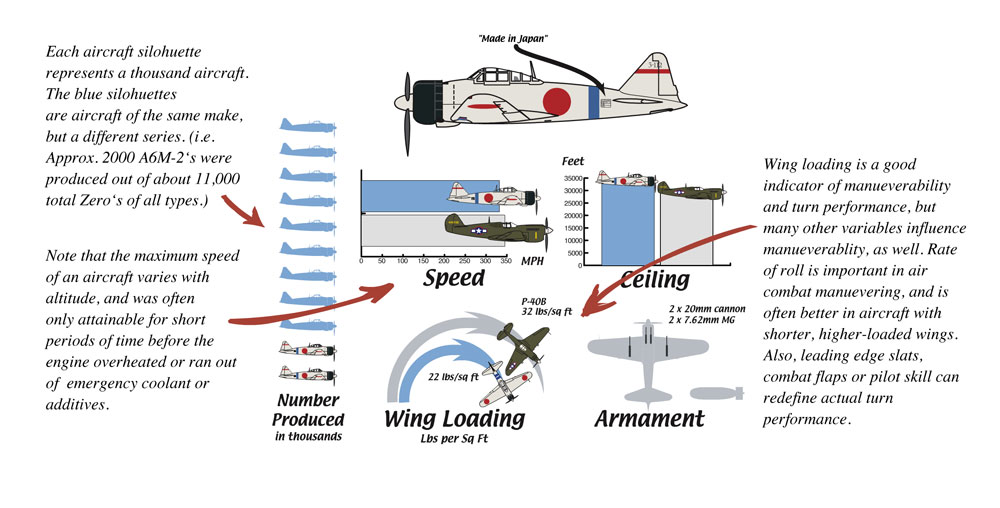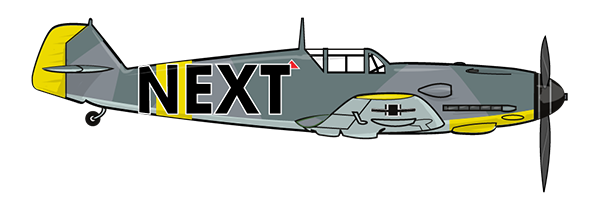A Field Guide to Major WW2 Combat Aircraft
Table of Contents
Select the aircraft you would like to learn more about below:
 |
 |
 |
 |
 |
 |
 |
|---|---|---|---|---|---|---|
| Japanese Aircraft | German Aircraft | Italian Aircraft | French Aircraft | British Aircraft | Soviet Aircraft | American Aircraft |
| A6M - Infamous "Zero" Ki84 - Late-war fighter B5N - Torpedo bomber D3A - Dive bomber G4M - Medium bomber |
Me109e - Fighter Me109g - Fighter Me110g - Night fighter Fw190 - Fighter Me262 - Jet fighter Stuka - Dive bomber He111 - Medium bomber Ju88 - Medium bomber Fi156 - Liason plane Ju52 - Transport |
M.C.202 - Fighter S.M.79 - Medium bomber |
D.520 - Fighter |
Hurricane - Fighter Spitfire Mk1 - Fighter Spitfire MkIX - Fighter Spitfire MkXIV - Fighter Tempest - Fighter Beaufighter - Night fighter Mosquito - Multi-role fighter Swordfish - Torpedo bomber Wellington - Medium bomber Lancaster - Heavy bomber Tiger Moth - Trainer Anson - Trainer |
I-16 - Fighter Mig-3 - Fighter Yak-1 - Fighter Yak-9 - Fighter Yak-3 - Fighter La-5fn - Fighter Il-2 - Famous 'Sturmovik' Il-4 - Medium bomber Pe-2 - Multi-role fighter Po-2 - Most useful plane ever |
P-39 - Fighter P-40 - Fighter P-38 - Fighter P-47 - Fighter P-51 - Fighter Wildcat - Carrier fighter Hellcat - Carrier fighter Corsair - Carrier fighter Dauntless - Dive bomber Avenger - Torpedo bomber B-25 - Medium bomber B-26 - Medium bomber B-17 - Heavy bomber B-24 - Heavy bomber B-29 - Heavy bomber PBY-5 - Flying boat C-47 - Transport L-4 - Liason plane AT-6 - Trainer |
A Field Guide to Major WW2 Combat Aircraft,
or at least the really cool looking ones
If you're like me, you love airplane books. Big, coffee-table-sized, lavishly illustrated books with lots of exciting photos and cutaways to pore over for hours. It's a good thing those books have lots of pictures, too, because they are often dreadfully boring to read. While it may conceivably be helpful to know that the Bf109 was powered by a Daimler-Benz dee-bee-five-oh-whatever producing so many horsepower at such and such an altitude, it certainly isn't light reading. So I took the liberty of preparing a kindler, gentler coffee table book, with all the boring technical bits left out. You don't even need a coffee table! What follows is still packed with information, but presented in an eye-friendly format for your amusement and enlightenment. The format should be easy enough to figure out, but below are a few comments that may provide you some further insights into what it all means...

It's hard to judge climb performance from these charts, but rate of climb is generally better in airplanes with the highest ceiling. Planes with low wing loading (lots of lift) or good horsepower-to-weight ratios will often break that rule of thumb (ouch!). Likewise, heavier planes tend to dive faster. For interesting factoids like this, you may have to break out a coffee table book, after all.
Bombers could often carry very heavy bombloads by leaving some gas or ammunition or sometimes even a crew member behind. Most of that stuff is pretty useful, though, so they tended to carry less than their maximum theoretical bombload. Therefore, bombloads are shown in grey for the typical mission, and in blue for more extraordinary situations. Alternative loadouts are also shown in this way: in grey if they were pretty common, and in blue if they were rare. Don't multiply the torpedoes or rockets by a thousand pounds, just the bombs. Fighters have their bombloads listed under armament rather than graphically portrayed like the bombers. Try not to get confused and send me hate mail. I could only fit so much stuff on the page. You'll figure it out. If it gets too stressful, check out a funny cartoon...

Table of Contents
(This is where all the planes are...)







